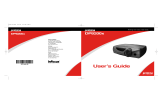
1
Declaration of Conformity
Manufacturer: InFocus Corporation, 27500 SW Parkway Ave. Wilsonville, Oregon
97070 USA
European Office: Louis Armstrongweg 110, 1311 RL Almere, The Netherlands
We declare under our sole responsibility that this projector conform to the following
directives and norms:
EMC Directive 2004/108/EC
EMC: EN 55022
EN 55024
EN 61000-3-2
EN 61000-3-3
Low Voltage Directive 2006/95/EC
Safety: IEC 60950-1: 1
st
Edition
Trademarks
Apple, Macintosh, and PowerBook are trademarks or registered trademarks of Apple
Computer, Inc. IBM is a trademark or registered trademark of International Business
Machines, Inc. Microsoft, PowerPoint, and Windows are trademarks or registered
trademarks of Microsoft Corporation. Adobe and Acrobat are trademarks or
registered trademarks of Adobe Systems Incorporated. HDMI, the HDMI logo and
High-Definition Multimedia Interface are trademarks or registered trademarks of
HDMI Licensing LLC. InFocus, In Focus, and INFOCUS (stylized) are either
registered trademarks or trademarks of InFocus Corporation in the United States and
other countries.
FCC Warning
This equipment has been tested and found to comply with the limits for a Class A
digital device, pursuant to part 15 of the FCC Rules. These limits are designed to
provide reasonable protection against harmful interference when the equipment is
operated in a commercial environment. This equipment generates, uses, and can
radiate radio frequency energy and, if not installed and used in accordance with the
instruction manual, may cause harmful interference to radio communications.
Operation of this equipment in a residential area is likely to cause harmful
interference in which case the user will be required to correct the interference at his
own expense. This device complies with part 15 of the FCC Rules.
Operation is subject to the following two conditions: (1) This device may not cause
harmful interference, and (2) this device must accept any interferences received,
including interference that may cause undesired operation.
Changes or modifications not expressly approved by InFocus Corporation may void
authority to operate the equipment.
EN 55022 Warning
This is a Class A product. In a domestic environment it may cause radio interference,
in which case the user may be required to take adequate measures. The typical use is
in a conference room, meeting room or auditorium.
Canada
This Class A digital apparatus complies with Canadian ICES-003.
Cet appareil numérique de la classe A est conforme à la norme NMB-003 du Canada.
Agency Approvals
UL, CUL
Other specific Country Approvals may apply, see please product certification label.
InFocus reserves the right to alter product offerings and specifications at any time
without notice.
This document applies to model W50: IN5106, C500, IN5102, C447.
Input ratings: 100-120/220-240Vac, 5.0/2.1A, 50/60Hz
Battery Safety Information
CAUTION: Risk of explosion if the battery in this projector is replaced with the
incorrect type of battery. See page 35 for battery replacement instructions.
Remote Control Warning
Laser radiation class II product; wavelength 650nm; maximum output 1mW. Remote
control complies with applicable requirements of 21 CFR 1040.10 and 1040.11. Remote
control complies with applicable requirements of EN 60825: 1994+A11+A2.




















